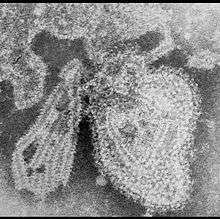Rubulavirus
Rubulavirus is a former genus of viruses in the family Paramyxoviridae, order Mononegavirales.[2][3] Humans, apes, pigs, and dogs serve as natural hosts. There are currently 17 species in the two genera Orthorubulavirus and Pararubulavirus.[3] Diseases associated with this genus include mumps.[4]
| Rubulavirus | |
|---|---|
 | |
| TEM micrograph of a Mumps rubulavirus particle | |
| Virus classification | |
| (unranked): | Virus |
| Realm: | Riboviria |
| Phylum: | Negarnaviricota |
| Class: | Monjiviricetes |
| Order: | Mononegavirales |
| Family: | Paramyxoviridae |
| Genus: | Rubulavirus |
| Type species | |
| Mumps rubulavirus | |
| Species[1] | |
| |
Taxonomy
| Species | Virus (Abbreviation) | NCBI Taxonomy Id |
| Achimota rubulavirus 1 | Achimota virus 1 (AchPV-1) | 1261100 |
| Achimota rubulavirus 2 | Achimota virus 2 (AchPV-2) | 1261101 |
| Bat mumps rubulavirus | bat mumps virus (BMV) | |
| Canine rubulavirus | parainfluenza virus 5 (PIV-5) | 11207 |
| Human rubulavirus 2 | human parainfluenza virus 2 (HPIV-2) | 11212 |
| Human rubulavirus 4 | human parainfluenza virus 4a (HPIV-4a) | 11224 |
| human parainfluenza virus 4b (HPIV-4b) | 11226 | |
| Mapuera rubulavirus | Mapuera virus (MapV) | 1979163 |
| Menangle rubulavirus | Menangle virus (MenPV) | 152219 |
| Mumps rubulavirus* | mumps virus (MuV) | 11161 |
| Porcine rubulavirus | La Piedad Michoacán Mexico virus (LPMV) | 53179 |
| Simian rubulavirus | simian virus 41 (SV-41) | 11228 |
| Sosuga rubulavirus | Sosuga virus | 1452514 |
| Teviot rubulavirus | Teviot virus (TevPV) | |
| Tioman rubulavirus | Tioman virus (TioPV) | 162013 |
| Tuhoko rubulavirus 1 | Tuhoko virus 1 (ThkPV-1) | 798072 |
| Tuhoko rubulavirus 2 | Tuhoko virus 2 (ThkPV-2) | 798073 |
| Tuhoko rubulavirus 3 | Tuhoko virus 3 (ThkPV-3) | 798074 |
Table legend: "*" denotes type species.
Related Viruses
Viruses of this genus appear to be most closely related to avulaviruses.[6]
Structure
Rubulavirions are enveloped, with spherical geometries. The diameter is around 150 nm. Rubulavirus genomes are linear, around 15kb in length. The genome codes for 8 proteins.[3][4]
| Genus | Structure | Symmetry | Capsid | Genomic arrangement | Genomic segmentation |
|---|---|---|---|---|---|
| Rubulavirus | Spherical | Enveloped | Linear | Monopartite |
The Disease
Rubulavirus causes mumps. Swollen and painful salivary glands are often a symptom of mumps, but swollen ovaries, testes, or pancreas can also caise symptoms. An infected person can even have no symptoms, which is the case for 20% of individuals who catch the disease. Other symptoms may include muscle aches, fatigue, headache, joint pain, loss of appetite, with infertility and hearing loss being the most serious complications.[7]
If not vaccinated against mumps, susceptible individuals catch the disease by breathing around an infected person who has coughed or sneezed, releasing their contaminated saliva. Those who have had mumps are usually immune to future infections of the disease. Children have the highest risk of catching mumps, and it is rare for an adult to contract mumps. The incubation period for mumps can range from a couple weeks to a month, while the illness period is a few weeks. The swelling of the salivary glands is caused when the virus travels from the respiratory tract to the salivary glands and multiplies within the glands, causing the glands to swell.[8]
Life cycle
Viral replication is cytoplasmic. Entry into the host cells is achieved after viral attachment to host cells. Replication follows the negative stranded RNA virus replication model. Negative-stranded RNA virus transcription, using polymerase stuttering, through co-transcriptional RNA editing is the method of transcription. The virus exits the host cell by budding. Humans, apes, pigs, and dogs serve as the natural host. Transmission routes are respiratory and saliva.[3][4]
| Genus | Host details | Tissue tropism | Entry details | Release details | Replication site | Assembly site | Transmission |
|---|---|---|---|---|---|---|---|
| Rubulavirus | Humans; apes; pigs; dogs | None | Glycoprotein | Budding | Cytoplasm | Cytoplasm | Aerosols; saliva |
References
- "Virus Taxonomy: 2018 Release" (html). International Committee on Taxonomy of Viruses (ICTV). October 2018. Retrieved 25 January 2019.
- Rima, B; Balkema-Buschmann, A; Dundon, WG; Duprex, P; Easton, A; Fouchier, R; Kurath, G; Lamb, R; Lee, B; Rota, P; Wang, L; ICTV Report Consortium (December 2019). "ICTV Virus Taxonomy Profile: Paramyxoviridae". The Journal of General Virology. 100 (12): 1593–1594. doi:10.1099/jgv.0.001328. PMID 31609197.
- "ICTV Report Paramyxoviridae".
- "Viral Zone". ExPASy. Retrieved 13 August 2015.
- Amarasinghe, Gaya K.; Bào, Yīmíng; Basler, Christopher F.; Bavari, Sina; Beer, Martin; Bejerman, Nicolás; Blasdell, Kim R.; Bochnowski, Alisa; Briese, Thomas (7 April 2017). "Taxonomy of the order Mononegavirales: update 2017". Archives of Virology. 162 (8): 2493–2504. doi:10.1007/s00705-017-3311-7. ISSN 1432-8798. PMC 5831667. PMID 28389807.
- McCarthy AJ, Goodman SJ (2010). "Reassessing conflicting evolutionary histories of the Paramyxoviridae and the origins of respiroviruses with Bayesian multigene phylogenies". Infect. Genet. Evol. 10 (1): 97–107. doi:10.1016/j.meegid.2009.11.002. PMID 19900582.
- "rubulavirus". NCBI PubMed Search.
- "Mumps". For Healthcare Providers. Center for Disease Control.
External links
- ICTV Report: Paramyxoviridae
- Viralzone: Rubulavirus
- http://www.biology-online.org/dictionary/Rubulavirus
- Virus Pathogen Database and Analysis Resource (ViPR): Paramyxoviridae
- Rubulavirus on ExPASy Proteomics from the Swiss Institute of Bioinformatics